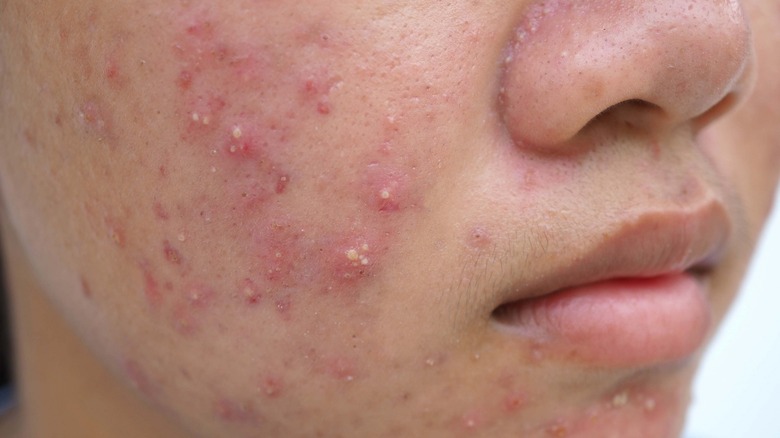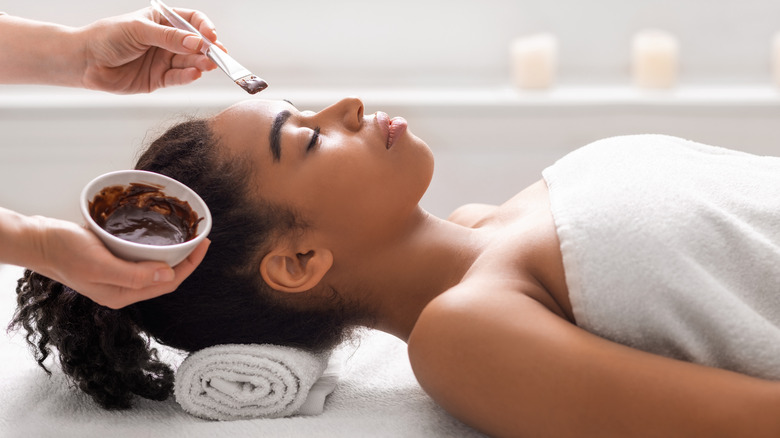Dealing With Nose Acne? Here's What Could Be Causing It
Acne breakouts are an unfortunate part of life, but some of us experience them more often than others. A number of factors, ranging from genetics and skin type, can play a role in the development of acne. The nose is one area where pimples can pop up, and needless to say, they can be an eyesore because they sit right at the center of your face.
Even those who don't frequently experience acne breakouts might occasionally find a zit on their nose. That said, some factors increase the chances of pimples appearing in this area. Turns out, pores — the openings in your skin that release sweat and oil, according to Cleveland Clinic — that are located on your nose tend to be larger compared to the rest of your face. This makes them more prone to clogging with excess oil and debris, which can result in pimples.
These days, a number of products on the market promise to unclog pores. Some of these are skincare treatments, such as exfoliants, while others are devices that remove debris, like pore vacuums. However, clearing your pores might not be necessary, even if you're experiencing several breakouts in a particular area like your nose. "Our body continually produces more oil, so clearing blockages gives only a temporary effect," board-certified dermatologist Joshua Zeichner told Cosmopolitan. "The pores usually fill up again within a few days."
Understanding the causes of nose acne
Nose acne forms for numerous reasons, though certain underlying conditions are recurrent when diagnosing its formation. Healthline defines two conditions frequently provoking nose pimples and cysts, which are acne rosacea and acne vulgaris. Within acne vulgaris, there are subtypes diagnosed as inflammatory or non-inflammatory. A person can experience both acne vulgaris and acne rosacea at the same time.
Acne vulgaris is aligned with general associations of nose acne like blackheads, pimples, pus-filled pores, and whiteheads. The condition arises from clogged pores and excess oil, called sebum, production which becomes trapped within the skin's layers or numerous pores of the nose. Medical News Today reports that inflammatory acne vulgaris is inclined to produce swollen nodes and tender, painful cysts caused by pus, sebum, and bacteria becoming trapped beneath the skin's top layers. The pressure of a cyst beneath the skin of the nose area induces swelling and inflammation. Non-inflammatory acne vulgaris encompasses more superficial acne caused by overactive sebum-producing sebaceous glands on the nose, resulting in superficial surface-level blackheads, whiteheads, and pimples on the nose.
Acne rosacea is hallmarked by swelling of tissue and skin around the nose, which can prompt the nose to appear larger. American Academy of Dermatology Association states acne rosacea is more likely to occur due to genetic predispositions frequently associated with Scandinavian and Celtic ancestry. Skin appears red due to an exacerbated reaction with specific bacteria called bacillus oleronius compounded with inflammation, which can trap acne-causing components within the skin.
How to prevent future nose acne breakouts
Once you make it out on the other side of an acne breakout, there's a good chance you aren't going to want to experience it again — regardless of whether it was on your nose. While you can't control your genetics, there are a few ways you can reduce the number of breakouts you experience in the future. Much of it has to do with your skincare routine.
Ideally, you'll want to start using products that line up with your skin type. Twice per day, wash your face with a gel-based cleanser. Afterward, using a medicated toner can remove any oil or dirt that may still be trapped in your pores. Moisturizing your face once it's been washed is essential, as it can prevent your skin from drying out and over-producing oil.
Keep in mind that if you're still breaking out after adopting a strict skincare routine, there may be some underlying causes, including hormone fluctuations — and it isn't only teenagers who experience them. Menstruation, pregnancy, and menopause can also alter your skin's oil production. Adding alpha hydroxy acids to your skincare routine, such as glycolic acid, can help speed up your skin cell turnover rate. As a result, dead skin cells may also be less likely to stick to areas like your nose, translating into fewer breakouts in the long run.


